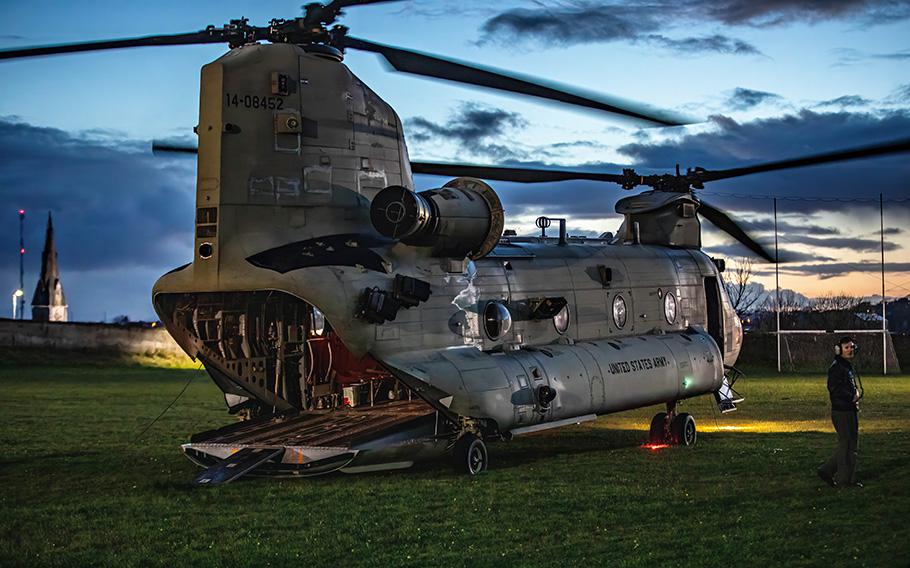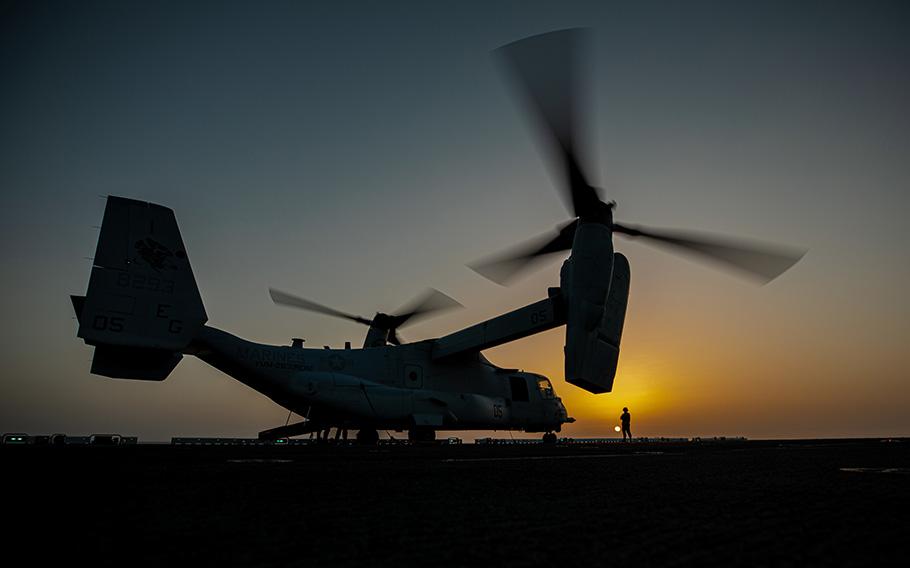
An Army Chinook prepares to transport President Joe Biden’s staff during his visit to Ireland on Friday, April 14, 2023. (William Thompson/U.S. Army)
Boeing Corp.'s top helicopter officials say the company needs more orders, or it will have to plan for the closing of the two main assembly lines at its Ridley Park complex along the Delaware River, the largest heavy-manufacturing employer in the Philadelphia area.
The Delaware County plant's production of updated Chinook CH-47F heavy-lift helicopters has fallen to around 20 a year, from 60 in 2021 and 2022, said Heather McBryan, the Boeing vice president who heads that program.
That is about the "minimum sustainable rate" that keeps the plant's many suppliers busy enough to stay open, McBryan said.
Boeing began making helicopters in Delaware County in 1960. Employment peaked at around 13,000 workers building the first generation of Chinooks, which were used to transport troops and equipment in the Vietnam War. The plant now employs around 4,100, down from 4,700 a couple of years ago.
McBryan and other Boeing helicopter leaders took questions Tuesday at the Ridley Park plant from U.S. and European defense-industry reporters, who toured the works in advance of next month's Paris Air Show, where Boeing and rival aircraft makers will parade their products.
"I wouldn't say the industrial base is comfortable" at that minimal level of production, McBryan said.
Companies across the region, such as Ehmke Manufacturing Co. in Juniata Park, maker of fiberglass foam thermal acoustic blankets for Chinook interiors, and Summit Aviation in Middletown, Del., where Boeing has tested products, have benefited when the Ridley Park plant is busy.
"It's trending down for now," McBryan said.
The future of the Chinook
While smaller orders from U.S. Special Forces and from Germany and other U.S. allies help keep the Chinook assembly line going, much depends on a U.S. Army decision whether to fully modernize its 470 Chinooks, boosting lifting capacity and electronics. That decision is expected "by the end of this year," McBryan added.
Boeing is producing about 80 Apache attack helicopters a year, four times the number of Chinooks at the current rate, at its newly expanded helicopter works in Mesa, Ariz., which employs 4,600. The Arizona plant is also restarting production of AH-6 "Little Bird" scout helicopters and houses other key Boeing operations.
Boeing officials stressed that if Chinook production stopped for a long period, it would be difficult to reassemble Chinook workers and suppliers.
Long-term plans to rebuild Chinooks for future service with more power and better electronics were approved by the Pentagon and funded by Congress in the mid-2000s, back when large U.S. forces still occupied much of Iraq and Afghanistan. Some of the improvements were designed to cope with desert conditions.
In 2018, military planners effectively suspended large, long-term orders for helicopters, armored-personnel carriers, trucks, and other vehicles familiar from U.S. wars in Asia since World War II. At that time, military officials said they needed to focus instead on long-range artillery, satellites, unmanned aircraft, and software to match China and Russia.
Worried about potential job cuts, the region's congressional delegation, including local Democrats plus Republicans from suppliers' districts, have been lobbying to reinstate the Army's larger Chinook program.

A U.S. Marine Corps MV-22 Osprey sits on the flight deck of the Wasp-class amphibious assault ship USS Kearsarge (LHD 3), in the Atlantic Ocean, on July 25, 2022. (Yvonna Guyette/U.S. Marine Corps )
The Ridley Park plant has a second line, which produces the V-22 Osprey, whose long-propellered twin engines tilt up so it can take off and land like a helicopter, and also tilt forward so it can fly like a plane. It's used to transport Marines from ships to combat much faster than helicopters, or to hover and land in disaster zones after rapid deployment.
Currently 36 Ospreys are scheduled for construction, which will keep Ridley Park's Osprey line busy for around "two more years," said Shane Openshaw, a former Army helicopter pilot who heads the Osprey program for Boeing.
Discussions to slow or stop the line "are starting," he added in response to questioning. The plans are "subject to new order flow."
The company has also tried to expand its helicopter product line. A Boeing-backed partnership failed last year to win Pentagon support to build Defiant X, the company's proposed replacement for today's Black Hawk helicopters. The Army instead picked a design from Textron Inc.
While Chinooks are in use by more than 20 U.S. allies, only Japan has followed the U.S. in buying Ospreys. Proposals to produce a civilian version have not resulted in an FAA-approved commercial tilt-rotor.
At times Tuesday, Boeing officials seemed to want to prepare the public for life after Chinook and Osprey.
To be sure, "folks come here and say it's the most beautiful factory in Boeing, that you can eat off the floor," said Kathleen "KJ" Jolivette, the new general manager for the Ridley Park and Mesa plants.
Beyond the assembly lines at the site, engineers and the company's Philadelphia Design Center do work for all Boeing helicopters, as well as for other Boeing businesses, including the commercial airliners built at factories in Washington and in the Midwest.
Will unmanned craft replace today's military helicopters?
Helicopters remain an important tool in nations' war arsenals, but the rapid growth in the use of unmanned aircraft in Syria, Libya, Armenia, and Ukraine in recent wars has forced military planners to consider big changes in the design and use of expensive manned aircraft.
"Technology is really changing at a rapid pace," said Rich Sikora, senior director for strategy for Boeing's Vertical Lift helicopter division. "These helicopters are going into harm's way. Does it always make sense to have manned helicopters?"
Boeing is looking into new products including unmanned rotorcraft and drones deployed from helicopters, he said.
Boeing is the largest but not the only helicopter factory in the region.
Leonardo's AgustaWestland plant at Northeast Philadelphia Airport, which employs more than 500, has partnered with Boeing to develop a new military helicopter, MH-139, based on a Leonardo civilian design sold to oil prospectors and police. The first should be ready next year, according to Azeem Khan, who heads the MH-139 program for Boeing.
The former Sikorsky helicopter plant in Coatesville, which made civilian aircraft as well as the Marine One choppers that transport the president, was shut last year following Sikorsky's takeover by Lockheed Martin. It has since been acquired by a group led by members of the Piasecki family, who continue to design new aircraft.
(c)2023 The Philadelphia Inquirer
Visit The Philadelphia Inquirer
Distributed by Tribune Content Agency, LLC.